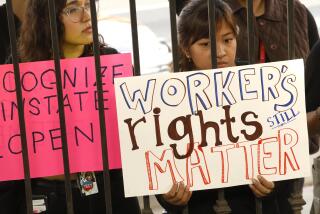Museum needs a fossil leg up
- Share via
PHILADELPHIA -- America’s oldest natural history institution has no intention of going the way of the dinosaur, but its nearly two centuries in existence have been almost as bumpy as the hide of a carnotaurus. The Academy of Natural Sciences, battered by budget problems, is crafting a multimillion-dollar plan to refurbish its exhibits, replenish its coffers and reinvigorate its staff in time for the venerable museum’s 200th birthday in 2012.
Undoubtedly, that’s a tall order, but it’s in keeping with the rule that applies to the millions of plants and animals in its esteemed collection: Adapt or die.
“It does need money to meet its operational needs, it does need money to grow, but it is not failing,” said William Brown, the academy’s new president. “It is not going to fail.”
The academy was founded in 1812 by a group of intellectuals with the progressive idea of presenting a secular and scholarly view of the world. Visitors know the academy for the dinosaur skeletons, but behind the scenes exist myriad research projects and a collection of 17 million fossil, plant and animal specimens, including Thomas Jefferson’s fossils and plants collected by Lewis and Clark.
In 2006, it came as a shock to many when the academy sold more than 18,000 specimens from its renowned mineral and gem collection to a private dealer for $1 million. The deal made front-page headlines and infuriated scientists, who considered it akin to pillaging.
Brown said the academy’s precarious position was far from unique in an age of increasing competition for philanthropic dollars, research money and the public’s leisure time.
“I would say our difference is that we show off our flaws with exuberance,” he said with a laugh. “We have tended to be extremely good at publicly disclosing the worst things going on, and that’s OK, but most other [museums] don’t do it.”
Upon his arrival in January, Brown halted the proposed sale of 7,300 exotic metals and crystals donated by William S. Vaux 125 years ago, when Philadelphia was considered the cradle of mineralogy. Now, curators are planning to bring the historic collection into public view for the first time in many decades.
“They’ve never been able to take the assets they started out with -- assets we’d all give our eye teeth for -- and realize them as much as they could,” said Dr. Hans-Dieter Sues, associate director for research and collections at Smithsonian National Museum of Natural History and vice president of the Natural Science Collections Alliance.
A five-year plan approved in June calls for doubling the current $60-million endowment and making roughly $30 million in improvements to exhibits, infrastructure and research labs. It also includes hiring new curators and scientists.
Brown has a reputation as a skillful fundraiser and is credited with similarly rescuing the Bishop Museum in Honolulu, where he worked. He said he believed he could do the same in Philadelphia.
More to Read
Sign up for Essential California
The most important California stories and recommendations in your inbox every morning.
You may occasionally receive promotional content from the Los Angeles Times.













